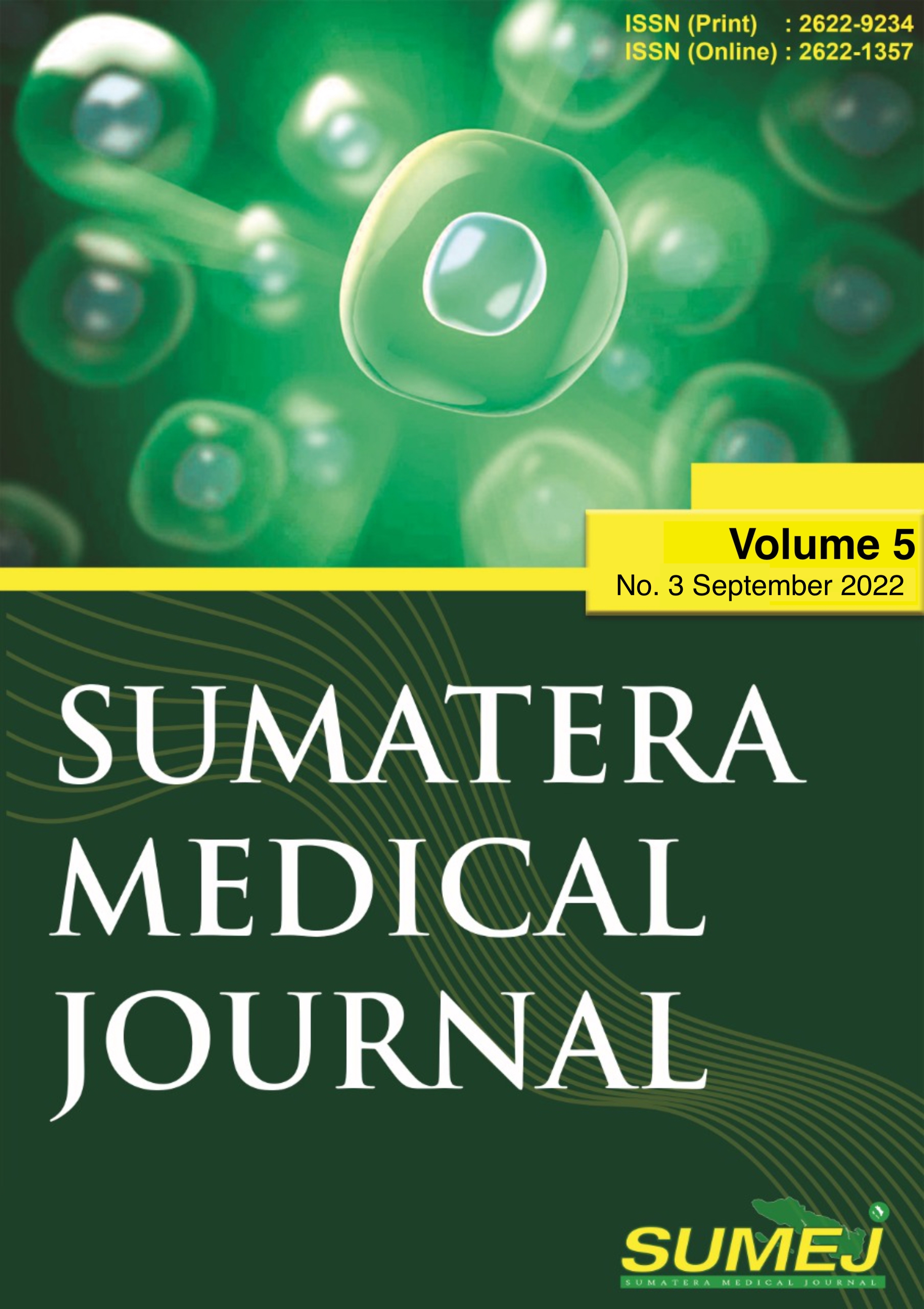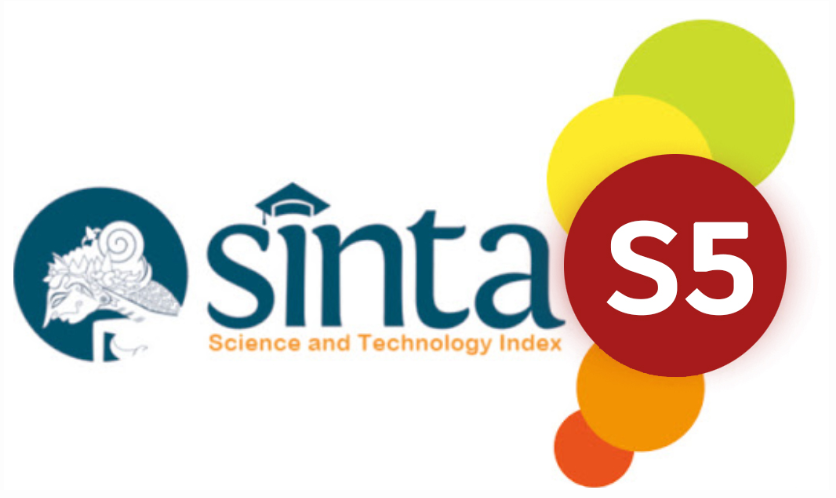Current Review of Atrial Fibrillation Detected After Stroke
DOI:
https://doi.org/10.32734/sumej.v5i3.9417Keywords:
Atrial fibrillation, atrial fibrillation detected after stroke, ischemic stroke, monitoringAbstract
Patients with atrial fibrillation (AF) have a greater probability of a stroke event than patients without AF. As a result of developments in cardiac monitoring, the diagnosis of AF during an ischemic stroke or transient ischemic attack has improved these years. More cases of AF detected after stroke (AFDAS) are reported, which has implications for future risk of recurrent stroke and prevention. This article provides the current review of AFDAS's monitoring and brief management.
Downloads
References
V. L. Feigin et al., “Global, regional, and national burden of stroke and its risk factors, 1990-2019: A systematic analysis for the Global Burden of Disease Study 2019,†The Lancet Neurology, vol. 20, no. 10, pp. 795–820, 2021, doi: 10.1016/S1474-4422(21)00252-0.
A. Gabet, C. Guenancia, G. Duloquin, V. Olié, and Y. Béjot, “Ischemic Stroke with Atrial Fibrillation: Characteristics and Time Trends 2006 to 2017 in the Dijon Stroke Registry,†Stroke, vol. 52, no. 6, pp. 2077–2085, 2021, doi: 10.1161/STROKEAHA.120.030812.
S. A. Lubitz et al., “Stroke as the Initial Manifestation of Atrial Fibrillation: The Framingham Heart Study,†Stroke, vol. 48, no. 2, pp. 490–492, 2017, doi: 10.1161/STROKEAHA.116.015071.
L. A. Sposato, M. Lam, B. Allen, L. Richard, S. Z. Shariff, and G. Saposnik, “First-ever ischemic stroke and increased risk of incident heart disease in older adults,†Neurology, vol. 94, no. 15, pp. e1559–e1570, 2020, doi: 10.1212/WNL.0000000000009234.
G. Hindricks et al., “2020 ESC Guidelines for the diagnosis and management of atrial fibrillation developed in collaboration with the European Association for Cardio-Thoracic Surgery (EACTS),†European Heart Journal, vol. 42, no. 5. pp. 373–498, 2021. doi: 10.1093/eurheartj/ehaa612.
D. O. Kleindorfer et al., “2021 Guideline for the prevention of stroke in patients with stroke and transient ischemic attack; A guideline from the American Heart Association/American Stroke Association,†Stroke, vol. 52, no. 7, pp. e364–e467, 2021, doi: 10.1161/STR.0000000000000375.
Y. X. Gue, T. S. Potpara, and G. Y. H. Lip, “Detection of Atrial Fibrillation on Stroke Units: Look Harder, Look Longer, Look in More Sophisticated Ways,†Cerebrovascular Diseases, vol. 49, no. 6, pp. 656–658, 2020, doi: 10.1159/000512205.
J. O. Cerasuolo, L. E. Cipriano, and L. A. Sposato, “The complexity of atrial fibrillation newly diagnosed after ischemic stroke and transient ischemic attack: Advances and uncertainties,†Current Opinion in Neurology, vol. 30, no. 1, pp. 28–37, 2017, doi: 10.1097/WCO.0000000000000410.
L. A. Sposato et al., “Atrial fibrillation detected after stroke is related to a low risk of ischemic stroke recurrence,†Neurology, vol. 90, no. 11, pp. e924–e931, 2018, doi: 10.1212/WNL.0000000000005126.
X. M. Yang et al., “Atrial Fibrillation Known Before or Detected After Stroke Share Similar Risk of Ischemic Stroke Recurrence and Death,†Stroke, vol. 50, no. 5, pp. 1124–1129, 2019, doi: 10.1161/STROKEAHA.118.024176.
A. Bhatt, A. Majid, A. Razak, M. Kassab, S. Hussain, and A. Safdar, “Predictors of occult paroxysmal atrial fibrillation in cryptogenic strokes detected by long-term noninvasive cardiac monitoring,†Stroke Research and Treatment, 2011, doi: 10.4061/2011/172074.
C. G. Favilla et al., “Predictors of Finding Occult Atrial Fibrillation after Cryptogenic Stroke,†Stroke, vol. 46, no. 5, pp. 1210–1215, 2015, doi: 10.1161/STROKEAHA.114.007763.
A. H. Tayal et al., “Atrial fibrillation detected by mobile cardiac outpatient telemetry in cryptogenic TIA or stroke,†Neurology, vol. 71, no. 21, 2008, doi: 10.1212/01.wnl.0000325059.86313.31.
M. Grond et al., “Improved detection of silent atrial fibrillation using 72-hour holter ecg in patients with ischemic stroke: A prospective multicenter cohort study,†Stroke, vol. 44, no. 12, pp. 3357–64, 2013, doi: 10.1161/STROKEAHA.113.001884.
M. A. Lazzaro, K. Krishnan, and S. Prabhakaran, “Detection of atrial fibrillation with concurrent Holter monitoring and continuous cardiac telemetry following ischemic stroke and transient ischemic attack,†Journal of Stroke and Cerebrovascular Diseases, vol. 21, no. 2, pp. 89–93, 2012, doi: 10.1016/j.jstrokecerebrovasdis.2010.05.006.
J. Liao, Z. Khalid, C. Scallan, C. Morillo, and M. O’Donnell, “Noninvasive cardiac monitoring for detecting paroxysmal atrial fibrillation or flutter after acute ischemic stroke: A systematic review,†Stroke, vol. 38, no. 11. pp. 2935–40, 2007. doi: 10.1161/STROKEAHA.106.478685.
T. Sanna et al., “Cryptogenic Stroke and Underlying Atrial Fibrillation,†New England Journal of Medicine, vol. 370, no. 26, pp. 2478–86, 2014, doi: 10.1056/nejmoa1313600.
R. B. Schnabel et al., “Searching for Atrial Fibrillation Poststroke: A White Paper of the AF-SCREEN International Collaboration,†Circulation, vol. 140, no. 22. pp. 1834–1850, 2019. doi: 10.1161/CIRCULATIONAHA.119.040267.
R. A. Bernstein et al., “Effect of long-term continuous cardiac monitoring vs usual care on detection of atrial fibrillation in patients with stroke attributed to large- or small-vessel disease: The stroke-af randomized clinical trial,†JAMA - Journal of the American Medical Association, vol. 325, no. 21, pp. 2169–2177, 2021, doi: 10.1001/jama.2021.6470.
R. Wachter et al., “Holter-electrocardiogram-monitoring in patients with acute ischaemic stroke (Find-AFRANDOMISED): an open-label randomised controlled trial,†The Lancet Neurology, vol. 16, no. 4, pp. 282–290, 2017, doi: 10.1016/S1474-4422(17)30002-9.
L. A. Sposato, S. Chaturvedi, C. Y. Hsieh, C. A. Morillo, and H. Kamel, “Atrial Fibrillation Detected after Stroke and Transient Ischemic Attack: A Novel Clinical Concept Challenging Current Views,†Stroke, vol. 29, no. 2, pp. e94–e103, 2022, doi: 10.1161/STROKEAHA.121.034777.
D. J. Gladstone et al., “Atrial Fibrillation in Patients with Cryptogenic Stroke,†New England Journal of Medicine, vol. 370, no. 26, pp. 2467–77, 2014, doi: 10.1056/nejmoa1311376.
E. M. Kloosterman, J. Z. Rosman, E. J. Berkowitz, M. Rosenbaum, and Z. A. Wettenstein, “Treatment of Cryptogenic Stroke Patients with Atrial Fibrillation Detected by Insertable Cardiac Monitors Reduces Recurrent Stroke Risk to Background Levels,†Journal of Innovations in Cardiac Rhythm Management, vol. 12, no. 12, pp. 4812–4817, 2021, doi: 10.19102/icrm.2021.121204.
M. v. Perez et al., “Large-Scale Assessment of a Smartwatch to Identify Atrial Fibrillation,†New England Journal of Medicine, vol. 381, no. 20, pp. 1909–1917, 2019, doi: 10.1056/nejmoa1901183.
A. K. Kishore, M. J. Hossain, A. Cameron, J. Dawson, A. Vail, and C. J. Smith, “Use of risk scores for predicting new atrial fibrillation after ischemic stroke or transient ischemic attack—A systematic review,†International Journal of Stroke, vol. 17, no. 6. pp. 608–617, 2021. doi: 10.1177/17474930211045880.
L. Garnier et al., “Multimodal Approach for the Prediction of Atrial Fibrillation Detected After Stroke: SAFAS Study,†Frontiers in Cardiovascular Medicine, vol. 9, Jul. 2022, doi: 10.3389/fcvm.2022.949213.
K. G. Haeusler et al., “Expert opinion paper on atrial fibrillation detection after ischemic stroke,†Clinical Research in Cardiology, vol. 107, no. 10, pp. 871–880, 2018, doi: 10.1007/s00392-018-1256-9.
E. Palà et al., “Blood-Based Biomarkers to Search for Atrial Fibrillation in High-Risk Asymptomatic Individuals and Cryptogenic Stroke Patients,†Frontiers in Cardiovascular Medicine, vol. 9, Jul. 2022, doi: 10.3389/fcvm.2022.908053.
S. Kany, B. Reissmann, A. Metzner, P. Kirchhof, D. Darbar, and R. B. Schnabel, “Genetics of atrial fibrillation-practical applications for clinical management: If not now, when and how?,†Cardiovascular Research, vol. 117, no. 7, pp. 1718–1731, 2021, doi: 10.1093/cvr/cvab153.
A. v. Khera et al., “Genome-wide polygenic scores for common diseases identify individuals with risk equivalent to monogenic mutations,†Nature Genetics, vol. 50, no. 9. pp. 1219–1224, 2018. doi: 10.1038/s41588-018-0183-z.
S. A. Lubitz et al., “Genetic risk prediction of atrial fibrillation,†Circulation, vol. 135, no. 14, pp. 1311–1320, 2017, doi: 10.1161/CIRCULATIONAHA.116.024143.
Downloads
Published
How to Cite
Issue
Section
License
Copyright (c) 2022 Sumatera Medical Journal

This work is licensed under a Creative Commons Attribution-NonCommercial-NoDerivatives 4.0 International License.
The Authors submitting a manuscript do so on the understanding that if accepted for publication, copyright of the article shall be assigned to Sumatera Medical Journal (SUMEJ) and Faculty of Medicine as well as TALENTA Publisher Universitas Sumatera Utara as publisher of the journal.
Copyright encompasses exclusive rights to reproduce and deliver the article in all form and media. The reproduction of any part of this journal, its storage in databases and its transmission by any form or media, will be allowed only with a written permission from Sumatera Medical Journal (SUMEJ).
The Copyright Transfer Form can be downloaded here.
The copyright form should be signed originally and sent to the Editorial Office in the form of original mail or scanned document.











